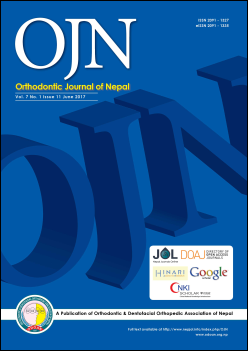Occurrence of Second Mesio-buccal Canal in Maxillary First Permanent Molar: A CBCT Study
DOI:
https://doi.org/10.3126/ojn.v7i1.18901Keywords:
CBCT, endodontic, mesio-buccal canal, Vertucci’s classificationAbstract
Introduction: Complexity in root canal morphology leads to chances of failure in endodontic treatment due to missed canal. Availability of Cone-beam Computed Tomography (CBCT) has contributed to assess second mesiobuccal canals in maxillary first molars.
Objective: To study the presence of second mesiobuccal (MB2) canals, classify morphology of canals according to Vertucci’s classification and to measure the distance between MB1 and MB2 canals.
Materials & Method: 72 CBCT scans including 115 permanent maxillary first molars were evaluated by endodontist and oral radiologist separately using Dicom software to study the mesiobuccal root canal morphology. Oral radiologist and endodontist individually evaluated the scans through coronal, axial and oblique views to study canal configurations. Vertucci’s Classification was used to classify the canal configurations. Statistical tests were done to assess the gender variation and arch side difference.
Result: Among 115 images evaluated; 30.4% samples had second mesiobuccal canal. The most common canal configuration was Type I (60.9 %) in mesiobuccal root. The mean distance between MB1 and MB2 canals was 2.39 mm in female and 2.56 mm in male.
Conclusion: The occurrence of second canal in mesiobuccal root of maxillary permanent molar is considerable in Nepali patients. CBCT can be an effective tool to detect MB2 canal and other complexities of root canal system to achieve clinical success
Downloads
Downloads
Published
How to Cite
Issue
Section
License
Copyright © held by Orthodontic & Dentofacial Orthopedic Association of Nepal
- Copyright on any research article is transferred in full to the Orthodontic & Dentofacial Orthopedic Association of Nepal upon publication in the journal. The copyright transfer includes the right to reproduce and distribute the article in any form of reproduction (printing, electronic media or any other form).
- Articles in the Orthodontic Journal of Nepal are Open Access articles published under the Creative Commons CC BY License (https://creativecommons.org/licenses/by/4.0/)
- This license permits use, distribution and reproduction in any medium, provided the original work is properly cited.




